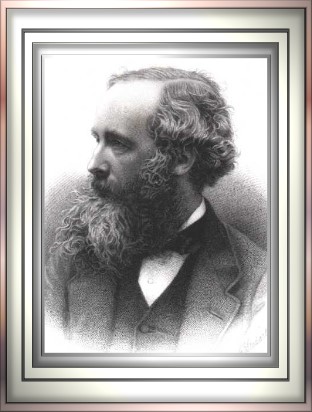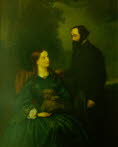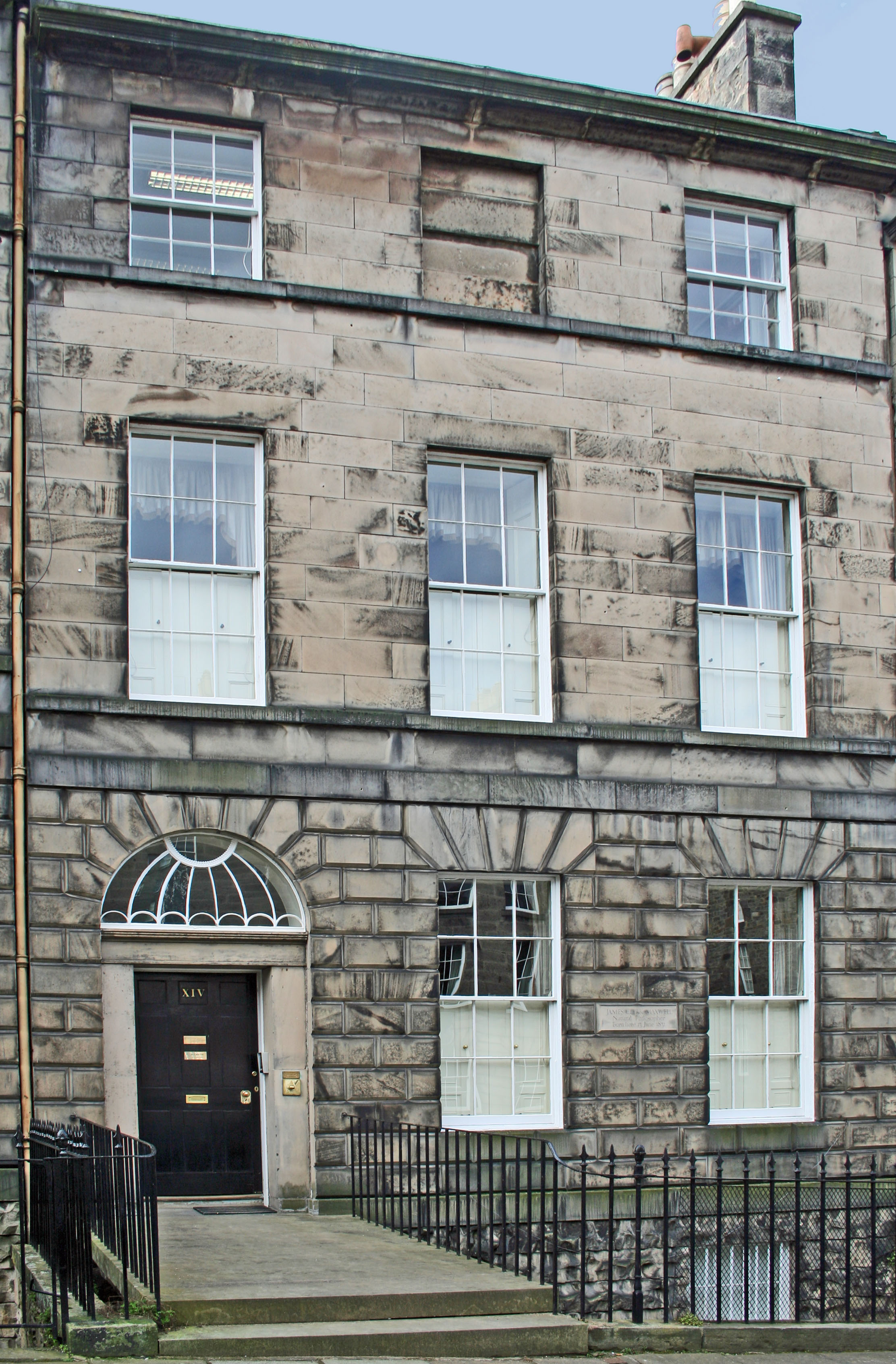





James Clerk Maxwell (1831-1879) was one of the greatest scientists who have ever lived. To him we owe the most significant discovery of our age - the theory of electromagnetism. He is rightly acclaimed as the father of modern physics. He also made fundamental contributions to mathematics, astronomy and engineering.

Read on to find out about his life (JCM and wife Katherine above), work, remarkable family, poetry, art etc.
John Arthur, our Foundation Curator, has recently published the 2nd edition of his book Brilliant Lives, The Clerk Maxwells and the Scottish Enlightenment, which describes James, his work and his remarkable family. The book is free to read on-line, and if you find it interesting, John asks that you please consider making a donation to the Foundation.
We are a small charity, and raise funds for our charitable activities promoting the achievements of James Clerk Maxwell.
On the 13th June 1831 James Clerk Maxwell was born in Edinburgh, at 14 India Street, a house built for his father in that part of Edinburgh's elegant Georgian New Town which was developed after the Napoleonic Wars. Although the family moved to their estate at Glenlair, near Dumfries, shortly afterwards, James returned to Edinburgh to attend school at The Edinburgh Academy. He continued his education at the Universities of Edinburgh and Cambridge. In 1856, at the early age of 25, he became Professor of Physics at Marischal College, Aberdeen. From there he moved first to King's College, London, and then, in 1871, to become the first Professor of Experimental Physics at Cambridge where he directed the newly created Cavendish Laboratory. It was at the Cavendish, over the next fifty years, that so much of the physics of today continued to develop from Maxwell's inspiration.
Modern technology, in large part, stems from his grasp of the basic principles of the universe. Wide ranging developments in the field of electricity and electronics, including radio, television, radar and communications, derive from Maxwell's discovery of the laws of the electromagnetic field - which was not a synthesis of what was known before, but rather a fundamental change in concept that departed from Newton's view and was to influence greatly the modern scientific and industrial revolution.
Find out more about his work and its impact
| 1831 | Born 13 June, 14 India Street |
| 1833 | Moved to Glenlair |
| 1841 | Enrolled, Edinburgh Academy |
| 1846 | Maxwell’s first paper “ On the description of oval curves and those having a plurality of foci” Proc Roy Soc Edinburgh, Vol. II |
| 1847–50 | Studied, University of Edinburgh |
| 1850 | Entered Peterhouse College, Cambridge - after one term migrated to Trinity College |
| 1854 | Mathematical Tripos – 2nd Wrangler and First (Equal) Smith’s Prizeman |
| 1856–60 | Appointed Professor of Natural Philosophy (physics) at Marischal College, Aberdeen |
| 1856 | Elected Fellow Royal Society Edinburgh (FRSE) aged 24 |
| 1857 | Essay on “The Stability of Saturn’s Rings” won the Adams Prize, University of Cambridge |
| 1858 | Marriage to Katherine Mary Dewar on 2 June, Old Machar, Aberdeen |
| 1860 | Paper “Illustrations of the Dynamical Theory of Gasses” where the Maxwell-Bolzman distribution for velocities in a gas are derived |
| 1860–65 | Appointed Professor of Natural Philosophy (physics) at Kings College, London |
| 1860 | Awarded Rumford Medal, Royal Society |
| 1861 | Royal Institution, first demonstration on colour reproduction |
| 1861 | Elected Fellow Royal Society (FRS) shortly before 30th birthday |
| 1861/2 | “On physical lines of force”, Phil. Mag. Vols. 21 & 23. Calculates that electric and magnetic effects travel at speed of light and states “..we can scarcely avoid the inference that light consists in the transverse undulations of the same medium which is the cause of electric and magnetic phenomena.” |
| 1864 | Famous oral presentation: “Dynamical theory of the electromagnetic field” presented to Royal Society containing ‘Maxwell’s Equations’ states “.. that it seems we have strong reason to conclude that light itself (including radiant heat and other radiations if any) is an electromagnetic disturbance in the form of waves propagated ……according to the electromagnetic laws” |
| 1865 | Above paper, “Dynamical theory of the electromagnetic field”, formally published in Phil. Trans. Roy. Soc., Vol. CLV, London |
| 1866 | Bakerian Lecture of the Royal Society: “On the viscosity or internal friction of air and other gases”, Phil. Trans. Roy. Soc. (Vol. CLVI) London. Includes measurements made in his London attic |
| 1868 | “On a method of making a direct comparison of electrostatic with electromagnetic force; with a note on the electromagnetic theory of light”, Phil. Trans. Roy. Soc. (Vol. CLVIII) London, Includes consequence of definitions of electromagnetic and electrostatic units of electric charge which makes their ratio equal to the speed of light |
| 1868 | “On governors”, Proc. Roy. Soc. (Vol. XVI) London. First mathematical treatment of feedback leading to control theory and cybernetics |
| 1869 | Awarded Keith Prize, Royal Society of Edinburgh |
| 1870 | “On reciprocal figures, frames and diagrams of forces”, Trans. Roy. Soc. Edinburgh Vol. 26. This follow-up to a paper by G B Airy on elasticity led to award (see above) of RSE Keith Medal |
| 1870 | “On hills and dales”, Phil. Mag. Vol. 40. An early contribution to the mathematics of topology |
| 1870 | Awarded Doctor of Law (LLD), University of Edinburgh |
| 1870 | Awarded Hopkins Prize, University of Cambridge |
| 1870 | Published his textbook “Theory of Heat” |
| 1871 | Directed and established Cavendish Laboratory, Cambridge, as First Professor of Experimental Physics |
| 1871 | Second lecture on colour at Royal Institution: “On colour vision” |
| 1873 | Publication of his “Treatise on Electricity and Magnetism“, Oxford University Press |
| 1874 | Elected Foreign Honorary Member, American Academy of Arts and Sciences, Boston |
| 1875 | Elected Member of American Philosophical Society of Philadelphia |
| 1875 | Elected Corresponding Member, Royal Society of Sciences of Göttingen |
| 1876 | Awarded Doctor of Civil Law (DCL), University of Oxford |
| 1876 | Elected Honorary Member, New York Academy of Sciences |
| 1877 | Published book ‘Matter and Motion’ |
| 1877 | Elected Member, Royal Academy of Sciences of Amsterdam |
| 1877 | Elected Foreign Corresponding Member, Mathematico-Natural-Science Class of the Imperial Academy of Sciences of Vienna |
| 1878 | Delivers Rede Lecture at Cambridge: “The Telephone” |
| 1878 | Volta Medal, Doctor of Sciences honoris causa, University of Pavia |
| 1879 | Dies of stomach cancer on 5 November, Cambridge. Buried in Parton, Castle Douglas, Galloway. |
| 2008 | Edinburgh statue unveiled on 25 November |
Edinburgh:
He was born in this elegant Georgian house in 1831. It now
displays a growing collection of heritage material associated with
him, his associates and family circle.
Visit in person or on line:
* Birthplace museum
* Edinburgh locations walking tour

14 India Street, Edinburgh

Entrance Hall
Aberdeen:
Maxwell's first job was professor of natural philosphy (physics) at Marischal College in 1856 where he met his future wife
...MORE.
(The Aberdeen pages were produced by former Trustee Dr John Reid 1942-2021.)
Cambridge: Later (1874) he set up the Cavendish Laboratory at Cambridge which houses a small museum ...MORE
Glenlair: His family's country estate was at Glenlair in Dumfries and Galloway, and he is buried in Parton churchyard there.
James Clerk Maxwell's Christian faith was very important to him. ...MORE
Maxwell is remembered in many different ways. He has memorials in Scotland and Westminster Abbey, his own panel on the Great Tapestry of Scotland, busts and a gargoyle, an imposing statue at a key location in central Edinburgh, an 'appearance' in a play about Einstein, ...MORE
One of the surprising things about about Maxwell is that, as well as being a great scientist, he was also a poet! If you would like to explore this aspect of his character then please download James C Rautio's digitized version of the Campbell and Garnet biography which includes a whole section on his poems.
Ivan Tolstoy, in his biography of Maxwell, wrote: 'Maxwell's importance in the history of scientific thought is comparable to Einstein's (whom he inspired) and to Newton's (whose influence he curtailed)"
"Since Maxwell's time, physical reality has been thought of as represented by continuous fields, and not capable of any mechanical interpretation. This change in the conception of reality is the most profound and the most fruitful that physics has experienced since the time of Newton" Albert Einstein
Maxwell said, in 'A Dynamic Theory of the Electro-Magnetic Field' given to the Royal Society in 1864: 'We have strong reason to conclude that light itself - including radiant heat and other radiation, if any - is an electromagnetic disturbance in the form of waves propagated through the electro-magnetic field according to electro-magnetic laws."
On which R V Jones commented: "This paper is the first pointer to the existence of radiation other than light and heat, and ranks as one of the greatest leaps ever achieved in human thought."
"He achieved greatness unequalled" Max Planck
"From a long view of the history of mankind - seen from, say, ten thousand years from now - there can be little doubt that the most significant event of the 19th century will be judged as Maxwell's discovery of the laws of electrodynamics" Richard P Feynman
You may like to ponder on the origins of his genius and the fact that no fewer than twelve relatives of James Clerk Maxwell FRS, FRSE were themselves Fellows of the Royal Society of Edinburgh, or the Royal Society in London, or both.
On his Father's side:
On his Mother's side
It is also notable that Maxwell grew up in an environment where art was practised and appreciated. His cousin Jemima Blackburn (nee Wedderburn) was herself a notable artist, and our knowledge of young James's childhood is enhanced by the delightful watercolours which Jemima painted. His aunt, Jane Cay, was also an accomplished artist and two of her watercolours (one depicting Maxwell as a young boy) are on display in the Birthplace, as is a pastel portrait of Jane and her sister Frances (Maxwell's mother) by their mother, Elizabeth Cay. This artistic influence is further demonstrated by the fact that six relatives of Maxwell had portraits painted by the famous Scottish portrait painter, Sir Henry Raeburn (1756-1823). These are:
Mother's side
Father's side
It is interesting to speculate on the influence which these artistic connections may have had on Maxwell's own work on light and the perception of colour.
JCM Foundation formed in Scotland in 1977.
Contact us.
Donations Welcome!
Privacy policy and cookies.